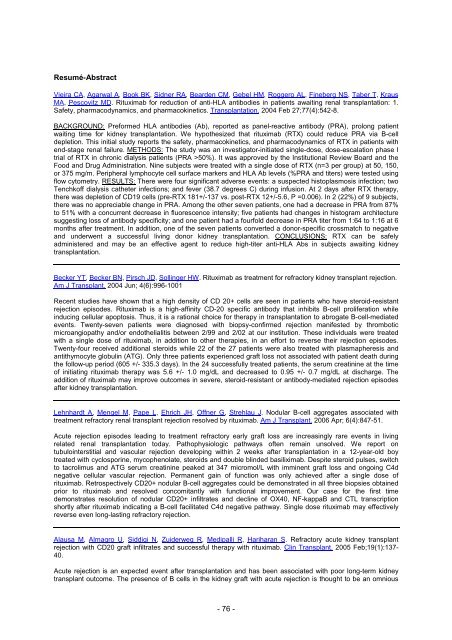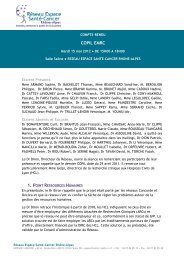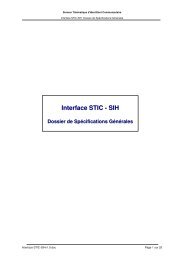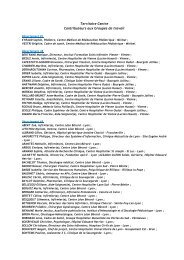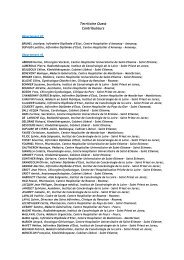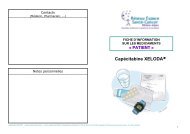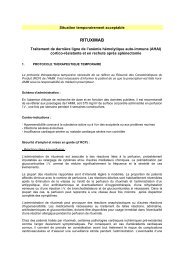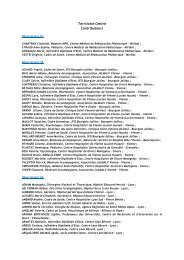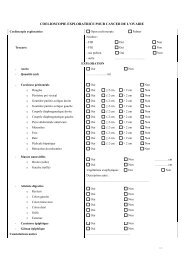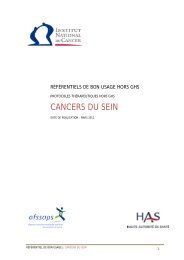rituximab
rituximab
rituximab
You also want an ePaper? Increase the reach of your titles
YUMPU automatically turns print PDFs into web optimized ePapers that Google loves.
Resumé-AbstractVieira CA, Agarwal A, Book BK, Sidner RA, Bearden CM, Gebel HM, Roggero AL, Fineberg NS, Taber T, KrausMA, Pescovitz MD. Rituximab for reduction of anti-HLA antibodies in patients awaiting renal transplantation: 1.Safety, pharmacodynamics, and pharmacokinetics. Transplantation. 2004 Feb 27;77(4):542-8.BACKGROUND: Preformed HLA antibodies (Ab), reported as panel-reactive antibody (PRA), prolong patientwaiting time for kidney transplantation. We hypothesized that <strong>rituximab</strong> (RTX) could reduce PRA via B-celldepletion. This initial study reports the safety, pharmacokinetics, and pharmacodynamics of RTX in patients withend-stage renal failure. METHODS: The study was an investigator-initiated single-dose, dose-escalation phase Itrial of RTX in chronic dialysis patients (PRA >50%). It was approved by the Institutional Review Board and theFood and Drug Administration. Nine subjects were treated with a single dose of RTX (n=3 per group) at 50, 150,or 375 mg/m. Peripheral lymphocyte cell surface markers and HLA Ab levels (%PRA and titers) were tested usingflow cytometry. RESULTS: There were four significant adverse events: a suspected histoplasmosis infection; twoTenchkoff dialysis catheter infections; and fever (38.7 degrees C) during infusion. At 2 days after RTX therapy,there was depletion of CD19 cells (pre-RTX 181+/-137 vs. post-RTX 12+/-5.6, P =0.006). In 2 (22%) of 9 subjects,there was no appreciable change in PRA. Among the other seven patients, one had a decrease in PRA from 87%to 51% with a concurrent decrease in fluorescence intensity; five patients had changes in histogram architecturesuggesting loss of antibody specificity; and one patient had a fourfold decrease in PRA titer from 1:64 to 1:16 at 6months after treatment. In addition, one of the seven patients converted a donor-specific crossmatch to negativeand underwent a successful living donor kidney transplantation. CONCLUSIONS: RTX can be safelyadministered and may be an effective agent to reduce high-titer anti-HLA Abs in subjects awaiting kidneytransplantation.Becker YT, Becker BN, Pirsch JD, Sollinger HW. Rituximab as treatment for refractory kidney transplant rejection.Am J Transplant. 2004 Jun; 4(6):996-1001Recent studies have shown that a high density of CD 20+ cells are seen in patients who have steroid-resistantrejection episodes. Rituximab is a high-affinity CD-20 specific antibody that inhibits B-cell proliferation whileinducing cellular apoptosis. Thus, it is a rational choice for therapy in transplantation to abrogate B-cell-mediatedevents. Twenty-seven patients were diagnosed with biopsy-confirmed rejection manifested by thromboticmicroangiopathy and/or endothelialitis between 2/99 and 2/02 at our institution. These individuals were treatedwith a single dose of <strong>rituximab</strong>, in addition to other therapies, in an effort to reverse their rejection episodes.Twenty-four received additional steroids while 22 of the 27 patients were also treated with plasmapheresis andantithymocyte globulin (ATG). Only three patients experienced graft loss not associated with patient death duringthe follow-up period (605 +/- 335.3 days). In the 24 successfully treated patients, the serum creatinine at the timeof initiating <strong>rituximab</strong> therapy was 5.6 +/- 1.0 mg/dL and decreased to 0.95 +/- 0.7 mg/dL at discharge. Theaddition of <strong>rituximab</strong> may improve outcomes in severe, steroid-resistant or antibody-mediated rejection episodesafter kidney transplantation.Lehnhardt A, Mengel M, Pape L, Ehrich JH, Offner G, Strehlau J. Nodular B-cell aggregates associated withtreatment refractory renal transplant rejection resolved by <strong>rituximab</strong>. Am J Transplant. 2006 Apr; 6(4):847-51.Acute rejection episodes leading to treatment refractory early graft loss are increasingly rare events in livingrelated renal transplantation today. Pathophysiologic pathways often remain unsolved. We report ontubulointerstitial and vascular rejection developing within 2 weeks after transplantation in a 12-year-old boytreated with cyclosporine, mycophenolate, steroids and double blinded basiliximab. Despite steroid pulses, switchto tacrolimus and ATG serum creatinine peaked at 347 micromol/L with imminent graft loss and ongoing C4dnegative cellular vascular rejection. Permanent gain of function was only achieved after a single dose of<strong>rituximab</strong>. Retrospectively CD20+ nodular B-cell aggregates could be demonstrated in all three biopsies obtainedprior to <strong>rituximab</strong> and resolved concomitantly with functional improvement. Our case for the first timedemonstrates resolution of nodular CD20+ infiltrates and decline of OX40, NF-kappaB and CTL transcriptionshortly after <strong>rituximab</strong> indicating a B-cell facilitated C4d negative pathway. Single dose <strong>rituximab</strong> may effectivelyreverse even long-lasting refractory rejection.Alausa M, Almagro U, Siddiqi N, Zuiderweg R, Medipalli R, Hariharan S. Refractory acute kidney transplantrejection with CD20 graft infiltrates and successful therapy with <strong>rituximab</strong>. Clin Transplant. 2005 Feb;19(1):137-40.Acute rejection is an expected event after transplantation and has been associated with poor long-term kidneytransplant outcome. The presence of B cells in the kidney graft with acute rejection is thought to be an omnious- 76 -


